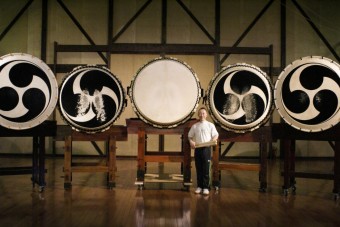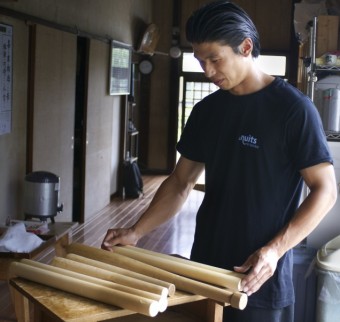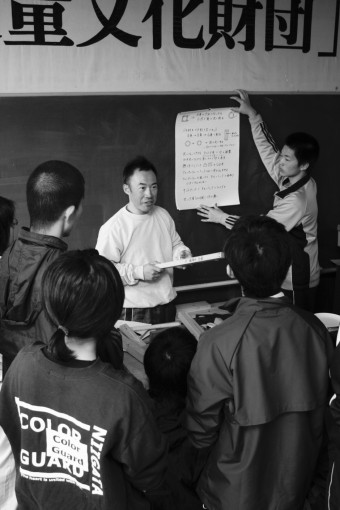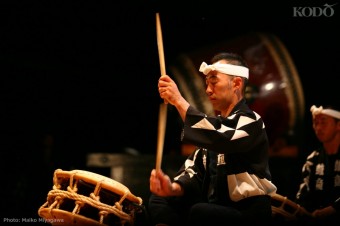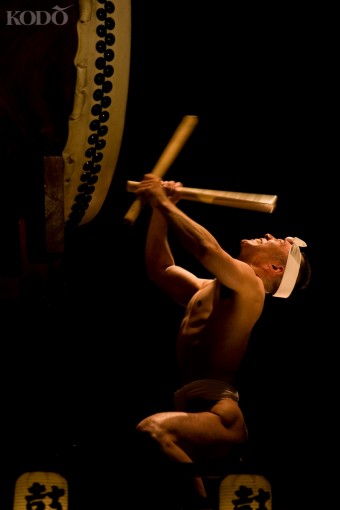“Valuable Lessons Performers Learn by Making Equipment” by Tomohiro Mitome
Sep. 1, 2014
This is Tomohiro Mitome, leader of taiko performing arts ensemble Kodo.
It is now September and little by little we can feel hints of autumn in the air. Actually, each year when the Ogi area falls quiet after the lively summer festivals, “Earth Celebration” and “Ogi Matsuri,” this calm feels like autumn has arrived all of a sudden.
This month, I would like to talk about my thoughts on making taiko drumsticks (bachi) and equipment.
I am constantly asked by taiko players, “Do you make your own drumsticks?” While it’s not every single pair, I do generally make my own drumsticks myself. This is connected to one of the core elements of Kodo’s Mission Statement: “Creating.”
When you become an apprentice and enter the Kodo Apprentice Centre, first you make your own chopsticks, then you make your own drumsticks. For the drumsticks, you use a saw to cut a square piece of timber to the right length, then using a plane you whittle the wood from a square piece into round sticks.
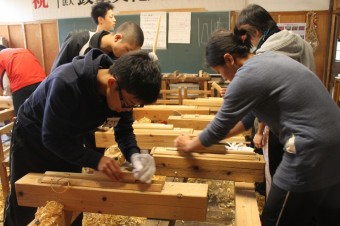
At first, you can’t make them well, but no matter how bumpy or oval your drumsticks are, they are filled with your blood, sweat and tears and you’ll be fond of them. And, it is a really huge shock when one of those drumsticks breaks. We really value them, so much so that we all keep our broken drumsticks for a special send-off, in the form of a lunar new year’s bonfire ritual each January.
Each pair of drumsticks is made from the same piece of wood, and if the sticks aren’t almost the same weight, the tone of the drum beats won’t be the same from your left and right hand. We are particular about our sound, so making drumsticks is very important to us.
In other words, for us, making drumsticks = making sound.
Every year, I instruct the apprentices in drumstick making and this is something that I tell them without fail:
“If you don’t value your drums, drumsticks, and equipment, your playing will not improve!!!”
I think this goes for everything, but if you treat your taiko poorly, your taiko will only give you a similiar response to that treatment. If you show the drums care and respect, that care and respect will come back to you in the form of sound.
It is the same with drumsticks.
Without drumsticks, taiko players can not beat the drums. The drumsticks go between a person and a drum, and the sticks convey people’s thoughts to the drums. One of my seniors once told me that is why in Japanese there is a word for “partner” (aibo) that is a compound of two kanji characters that mean “together” and “stick.”
To make drumsticks, you need a plane. A new plane cuts very well, but as we use it over and over, the blade becomes blunt and will not cut anymore.
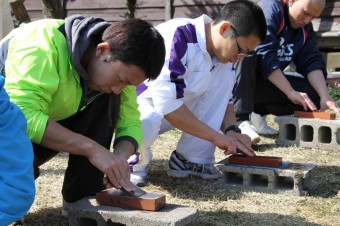
To make good drumsticks, we need to take care of the plane. We must to know its structure and how to sharpen the blade so we can use it to make beautiful drumsticks. That leads me to equipment maintenance.
This topic reminds me of the late Mr. Junji Saisu, a joinery craftsman who made so many of the taiko stands, drum carts, and other pieces of equipment we use on the Kodo stage.
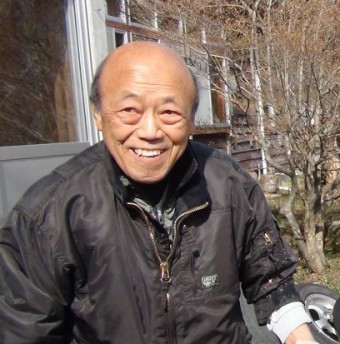
Mr. Saisu’s work was amazing and we asked him to make most of our stage equipment during his lifetime. He always accepted our orders, even the most difficult requests, and made us stage equipment that were all “works of art,” above and beyond our expectations.
His work was that of a time-honoured Japanese craftsman, filled with craftsman spirit. This is something I would like to uphold.
However, nowadays in modern society, some of these crafts have no successors to be passed on to and apparently many crafts fade away. It is same with performing arts. Some of them are in danger of disappearing and others have already vanished. Whenever we hear about it, we regret what we have lost and at the same time we hope to somehow be able to leave those numerous treasures to future generations.
Taiko drums are instruments created from living things, from cows and trees. If we don’t pour our heart and soul into each beat, the sound won’t resonate in the hearts of others.
I will continue to convey this important attitude for a performer to the apprentices so that their hearts, feelings, and values will naturally appear in the sound they create.




